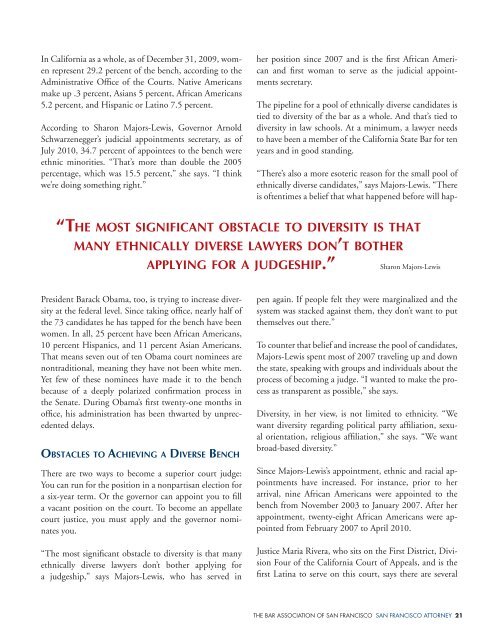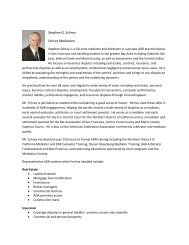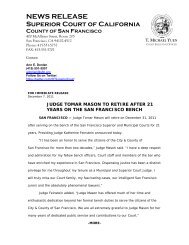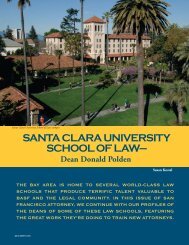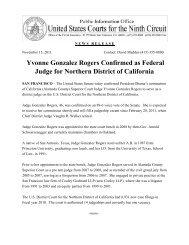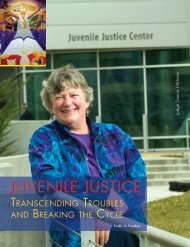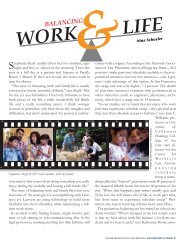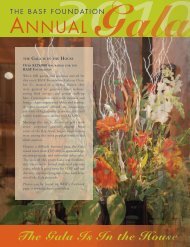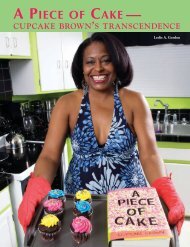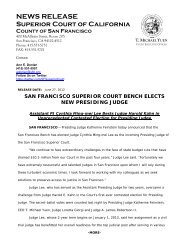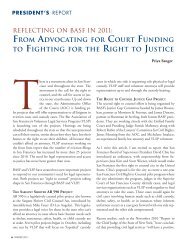BENCHâ - The Bar Association of San Francisco
BENCHâ - The Bar Association of San Francisco
BENCHâ - The Bar Association of San Francisco
You also want an ePaper? Increase the reach of your titles
YUMPU automatically turns print PDFs into web optimized ePapers that Google loves.
In California as a whole, as <strong>of</strong> December 31, 2009, womenrepresent 29.2 percent <strong>of</strong> the bench, according to theAdministrative Office <strong>of</strong> the Courts. Native Americansmake up .3 percent, Asians 5 percent, African Americans5.2 percent, and Hispanic or Latino 7.5 percent.According to Sharon Majors-Lewis, Governor ArnoldSchwarzenegger’s judicial appointments secretary, as <strong>of</strong>July 2010, 34.7 percent <strong>of</strong> appointees to the bench wereethnic minorities. “That’s more than double the 2005percentage, which was 15.5 percent,” she says. “I thinkwe’re doing something right.”her position since 2007 and is the first African Americanand first woman to serve as the judicial appointmentssecretary.<strong>The</strong> pipeline for a pool <strong>of</strong> ethnically diverse candidates istied to diversity <strong>of</strong> the bar as a whole. And that’s tied todiversity in law schools. At a minimum, a lawyer needsto have been a member <strong>of</strong> the California State <strong>Bar</strong> for tenyears and in good standing.“<strong>The</strong> most significant obstacle to diversity is thatmany ethnically diverse lawyers don’t botherapplying for a judgeship.”Sharon Majors-LewisPresident <strong>Bar</strong>ack Obama, too, is trying to increase diversityat the federal level. Since taking <strong>of</strong>fice, nearly half <strong>of</strong>the 73 candidates he has tapped for the bench have beenwomen. In all, 25 percent have been African Americans,10 percent Hispanics, and 11 percent Asian Americans.That means seven out <strong>of</strong> ten Obama court nominees arenontraditional, meaning they have not been white men.Yet few <strong>of</strong> these nominees have made it to the benchbecause <strong>of</strong> a deeply polarized confirmation process inthe Senate. During Obama’s first twenty-one months in<strong>of</strong>fice, his administration has been thwarted by unprecedenteddelays.Obstacles to Achieving a Diverse Bench<strong>The</strong>re are two ways to become a superior court judge:You can run for the position in a nonpartisan election fora six-year term. Or the governor can appoint you to filla vacant position on the court. To become an appellatecourt justice, you must apply and the governor nominatesyou.“<strong>The</strong> most significant obstacle to diversity is that manyethnically diverse lawyers don’t bother applying fora judgeship,” says Majors-Lewis, who has served in“<strong>The</strong>re’s also a more esoteric reason for the small pool <strong>of</strong>ethnically diverse candidates,” says Majors-Lewis. “<strong>The</strong>reis <strong>of</strong>tentimes a belief that what happened before will happenagain. If people felt they were marginalized and thesystem was stacked against them, they don’t want to putthemselves out there.”To counter that belief and increase the pool <strong>of</strong> candidates,Majors-Lewis spent most <strong>of</strong> 2007 traveling up and downthe state, speaking with groups and individuals about theprocess <strong>of</strong> becoming a judge. “I wanted to make the processas transparent as possible,” she says.Diversity, in her view, is not limited to ethnicity. “Wewant diversity regarding political party affiliation, sexualorientation, religious affiliation,” she says. “We wantbroad-based diversity.”Since Majors-Lewis’s appointment, ethnic and racial appointmentshave increased. For instance, prior to herarrival, nine African Americans were appointed to thebench from November 2003 to January 2007. After herappointment, twenty-eight African Americans were appointedfrom February 2007 to April 2010.Justice Maria Rivera, who sits on the First District, DivisionFour <strong>of</strong> the California Court <strong>of</strong> Appeals, and is thefirst Latina to serve on this court, says there are severalTHE BAR ASSOCIATION OF SAN FRANCISCO SAN FRANCISCO ATTORNEY 21


